We all love the dancing that we’re doing, but do we know where it comes from? At Swing in Utrecht we’d like to offer you a reasonably in-depth, though imperfect view at the history of the music and the dances. Knowing where it comes from gives people an insight into what kind of dance they’re doing, why it ticks the way it ticks, how it evolved into what it is now, and also to make sure you appreciate its origins.
We’ve provided as many sources as possible, linked at the end of this article. If you see incorrect statements or gaps that you would like to address, please feel free to contact us! We would really appreciate it.
The origins of Lindy Hop, Jazz and other Swing dances are rooted in the experiences of black people in the United States. A big influence was Africans being enslaved in North America as early as the beginning of the 16th century when the Atlantic slave trade transported captives to American plantations.
Very specifically the Africans were split up and mixed so that no one plantation had people speaking the same language and sharing the same culture. However, these people developed dances strongly influenced by a variety of originally African dances, rhythms, and melodies. Using dance and music they could overcome the barrier of language that divided Africans with different backgrounds and cultures: the dance itself represented a narrative of resistance and survival. [1] [2]
One of the key differences between European and African slave culture was the way religion was integrated into their dance. In European culture there was a distinct boundary between sacred and secular, while in black Africa this distinction did not exist, before Christianity made real inroads on the continent. While African dances were seen as savage in the mind of European Americans, they were actually deeply ingrained with religious meaning. [3]
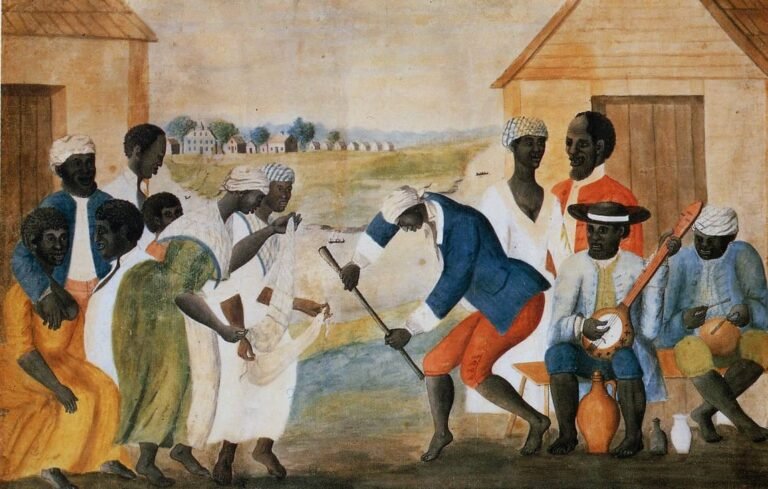
The Old Plantation
(Slaves Dancing on a South Carolina Plantation), ca. 1785-1795, attributed to John Rose
Frequently African slaves also danced in defiance of their owners by giving their dances subtle meanings that would usually go over their white owner’s head. For example, on the ships that brought them from Africa to the Americas, where they were ordered to play games and exercise to stay fit, they performed the Limbo in the Caribbean, symbolizing the literal tightness of the ships and the African ability to overcome it.[1] Another example could be the Cakewalk, which was a partner dance with comical formality that might have been a subtle mockery of the mannered dances of white slaveholders. [4]
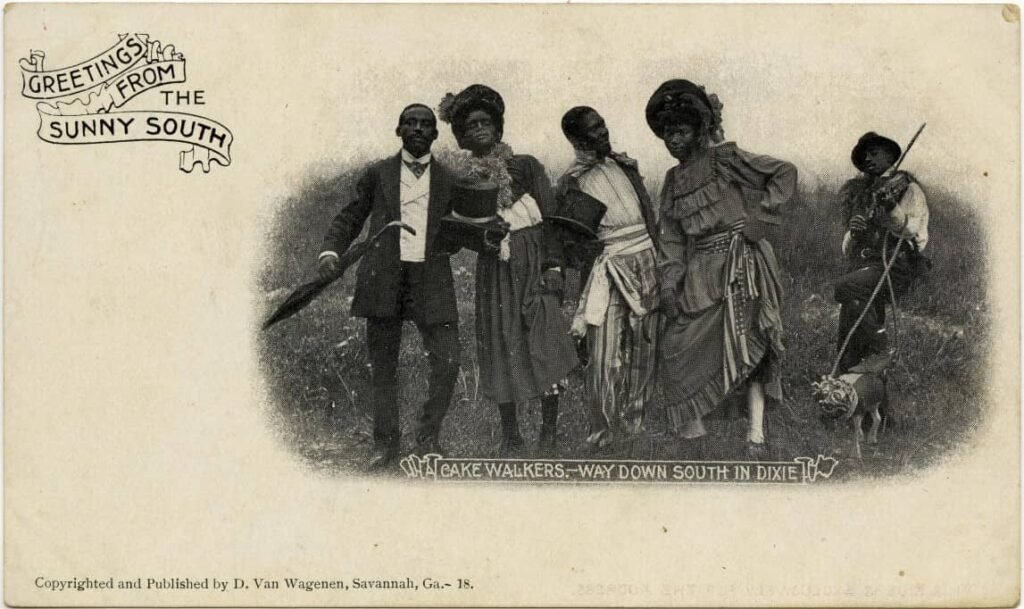
Cake Walkers – Way Down South in Dixie
From Hoffman/Boaz Postcard Collection from the National Museum of American History
Following the American Civil War, in which many African Americans fought for their independence, and the subsequent abolishment of slavery in the United States, the country became heavily segregated. [5] It was at this time that Blues originated, although unfortunately its beginnings are poorly documented. This is partly due to racial discrimination and partly because of the low rate of literacy among rural African Americans at the time. [6] But the music genre, Blues, may have originated as early as the 1860s in the Deep South..[7]
Blues incorporated work songs, field hollers, shouts chants and rhymed simple narrative ballads from the African-American culture. It’s characterized by the call-and-response pattern and what’s called Blue notes (or “worried notes”), usually thirds, fifths or sevenths flattened in pitch, which are elements that can be traced back to the music of Africa. [8]

Young African Americans dancing in a juke joint in Mississippi from unknown source
Because of poor economic conditions and lynchings in the South of America, the mostly rural African Americans became disenfranchised and decided to migrate into other regions of the United States. There they created many black communities. [9][10] One such example was the community in New Orleans, Louisiana, where Jazz had its origins. Jazz had roots in Blues and Ragtime and was characterized by Swing and blue notes, complex chords, call-and-response vocals, polyrhythms and improvisation.[11][12]
Another black Community was the one in Harlem, New York, where there was an intellectual and cultural revival of African-American music, dance, art, fashion, literature, theater, politics and scholarships called the Harlem Renaissance. [13] To escape the harsh economic realities that the African Americans faced at their monotonous jobs, people went to social dances, which were usually “Rent parties”.
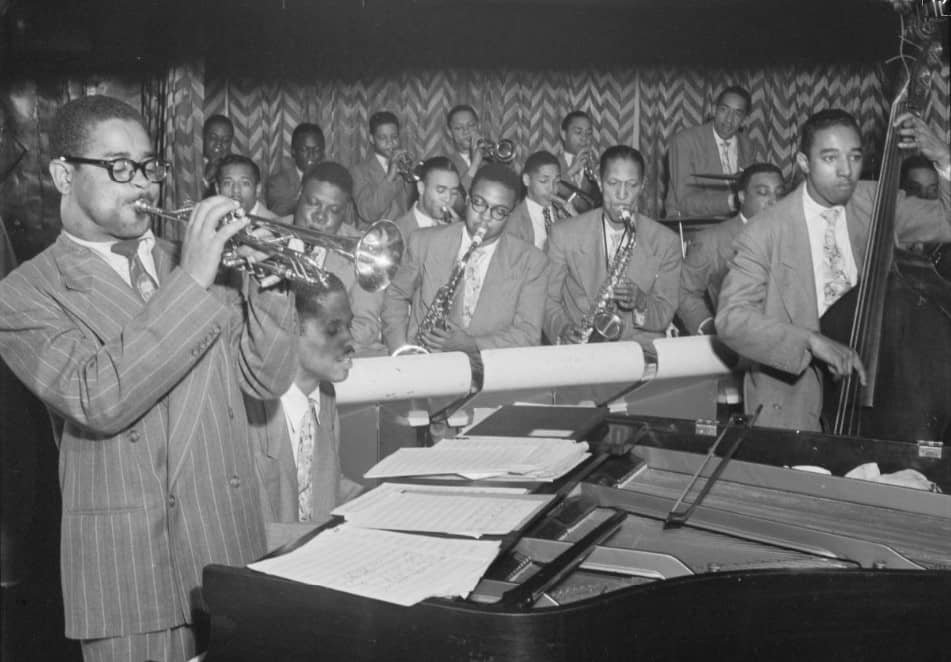
Dizzy Gillespie, John Lewis, Cecil Payne, Miles Davis and Ray Brown (among others) depicted in a 1917 photograph by William P. Gottlieb
Because of rising rents due to the housing crisis, some people decided to organize parties with an entrance fee of about 25 cents (which, corrected for inflation would be about $4.45 nowadays) where, for a little extra money, people could get to have some home-made fried food, and loads of alcohol, but most of all… they could dance to piano music or bands. It gave people a chance to cut loose after a hard work week, it gave the hosts the ability to pay the rent, it let you enjoy the newest music, it was a cheap way to get a home-cooked meal (way cheaper than going to a club) and of course it gave you access to alcohol, which was illegal due to the prohibition. Which is also why these parties were kept a secret, by using business cards and leaflets as tickets that had quirky rhymes or euphemisms, without explicitly identifying the event as a rent party. Usually they would be called “Social Parties” or “Social Dances” to try to avoid the police.
During these rent-parties (also sometimes known as shindigs because people were so closely packed they would dig into other people’s shins) the highly improvisational dance form known as Lindy Hop was born. [14][15][16][17][18] It took its influences from Tap and Charleston with similar footwork and timings.[19] But it wasn’t until the influence of Breakaway that Lindy Hop came more into its own; Breakaway introduced the ‘Swing out’ and ‘open positions’ of dances such as the Texas Tommy. [20]
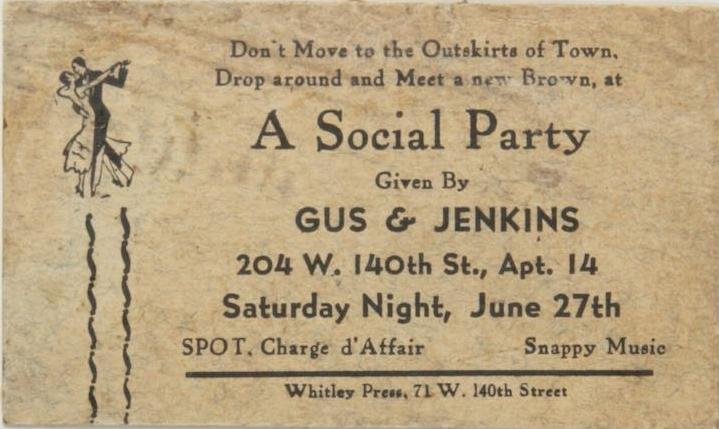
Rent party card from the Hughes, Langston collection provided by Yale University Library
On March 12th, 1926 the Savoy Ballroom, one of many Harlem hot spots, opened its doors to a huge amount of Lindy Hop (among other dance forms) social nights. It would become known as “The Heartbeat of Harlem”, “The King of Swing”, and the “World’s Finest Ballroom”. [21][22][23] It was over 3000 square meters in size and could house up to 5000 people [20], both black and white because they had a no-discrimination policy. Now famous Lindy Hopper Frankie Manning recounts that people weren’t judged on the color of their skin, but on their dancing skills. “One night somebody came over and said, ‘Hey man, Clark Gable just walked in the house.’ Somebody else said, ‘Oh, yeah, can he dance?’ All they wanted to know when you came into the Savoy was, do you dance?”. [24]
What’s also important to know is that there weren’t really any lessons. You went onto the floor and just got into the groove and danced. The Lindy Hop we are dancing today is far more inspired by the performances by for example Whitey’s Lindy Hoppers, likely due to the surviving footage. There were weekly competitions that promoted friendly rivalries between dance troupes, encouraging them to come up with newer and more exciting moves to impress the audience. One such moment would come in the form of Frankie Manning and Freda Washington performing the first Aerial move. [23] The Savoy also had a double bandstand, meaning that the music continued all throughout the night without breaks as the next band was always in position and ready to take over.[25] Just like the dancers fed off the music, the players fed off the dancer’s improvisation, creating an electric atmosphere.[23]
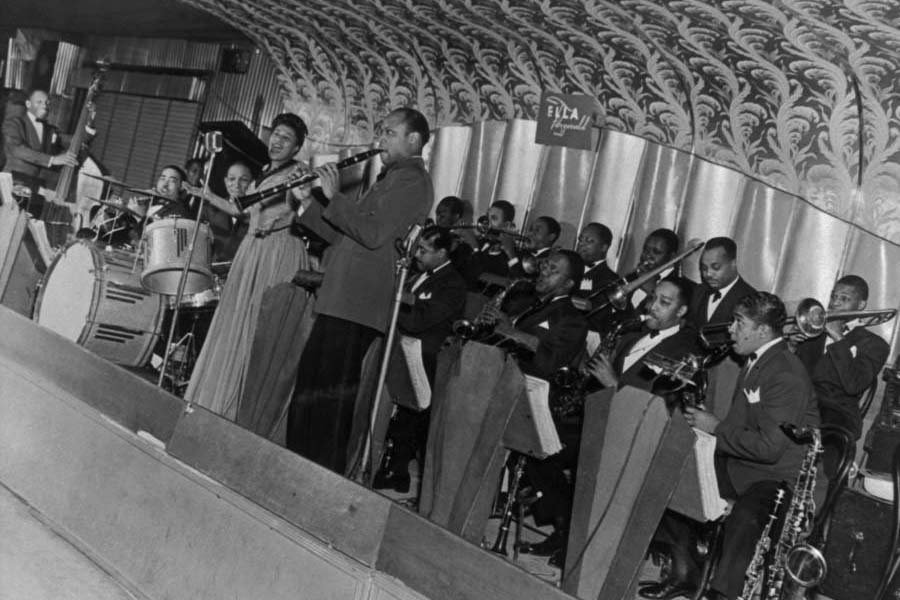
1941 – Ella Fitzgerald Orchestra on the Savoy bandstand. Looking towards the 141st Street rear corner, by Frank Driggs Collection, Magnum Photos
There really is no confirmed origin of the term Lindy Hop, but one prevailing theory is that in 1928 at the Rockland Palace ballroom, “Shorty” George Snowden was asked what he was doing with his feet and he said “The Lindy” referring to Charles “Lindy” Lindbergh’s transatlantic airplane flight, from New York to Paris, and the name stuck. However, there is some evidence to suggest this anecdote didn’t happen as described, so take that with a pinch of salt. [23][26]
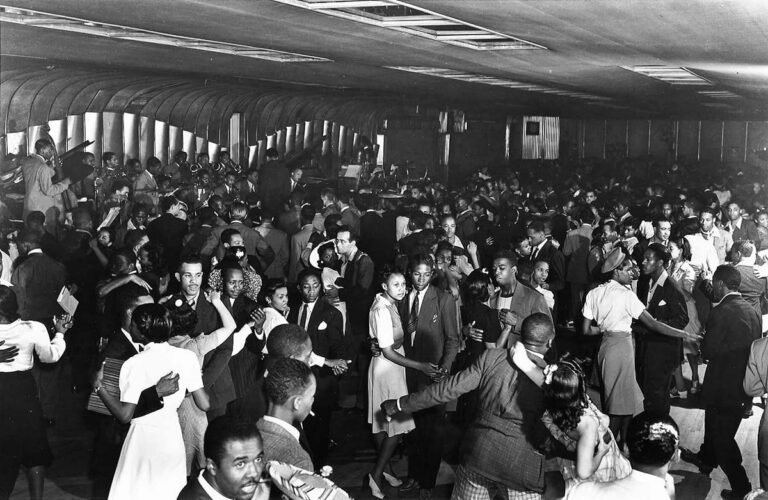
1941 – Wide angle view of the Savoy Ballroom dance floor, bandstand and 140th Street rear corner from unknown source
Unfortunately, much of Collegiate Shag’s history is unclear, not aided by the fact that the word ‘shag’ has come to have different meanings. To make matters more complicated, very likely it wasn’t even called Shag in its heyday, but the ‘Flea Hop’. The ‘Collegiate’ part is only in reference to who the people were that danced it; in this case, it was the college kids that were dancing it. The term Collegiate Shag was coined by Bernie Sager in 1940, though he likely did not invent it. [27][28][29]
Collegiate Shag is primarily danced to fast Ragtime – Jazz type music at 185-250+ beats per minute. Mostly popular among white youth and college students, Collegiate Shag swept the ballrooms of New York and even overtook and overcrowded the Savoy ballroom during the rage. [29]
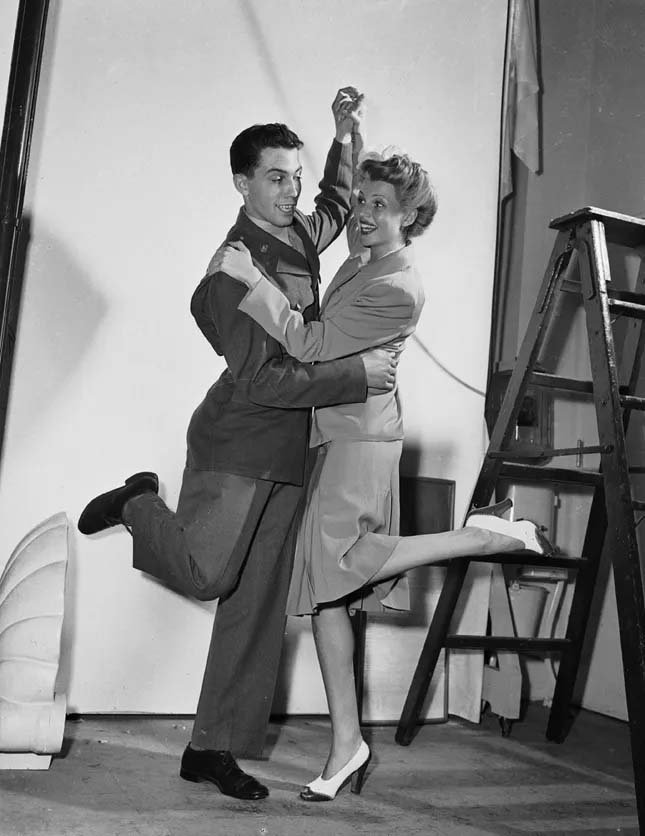
Rita Hayworth dancing Collegiate Shag with her brother Vernon, Cansino 1934, Photo by Robert Coburn Sr.
During World War 2 many top performers were called into military service, including Frankie Manning and members of Whitey’s Lindy Hoppers, prompting the disbanding of the group. After the war, new taxes and legislation limited the venue’s ability to employ musicians and dancers. Music changed, as Bebop and cool Jazz were gaining popularity, which required the audience to pay attention and listen, instead of dancing. Rock and Roll and Bebop slowly replaced the popularity of Jazz and Lindy Hop faded into the background.
That doesn’t mean that Lindy Hop died, though. In many African-American communities in America Swing dancing was still being danced in, for example, community centers. It wasn’t until the 1980s when in New York City, California, Stockholm and the United Kingdom Lindy became mainstream again. Old dancers like Norma Miller and Frankie Manning came out of retirement to teach and started touring the world. [23][30] During the 80s Swing became more popular as Hollywood and music artists drew inspiration from the iconic Savoy Ballroom and Small Paradise, and in 1989 Frankie Manning won a Tony Award for his choreography for the musical Black and Blue. Thus began the Neo-Swing era in the 1990s. Lindy Hop spread throughout Europe and America and is perhaps more popular now than in its heyday. [23]
It is essential to acknowledge the dance’s history and pay tribute to its pioneers in order to foster a respectful appreciation. Only then can we ensure cultural understanding and inclusivity within the Swing community.
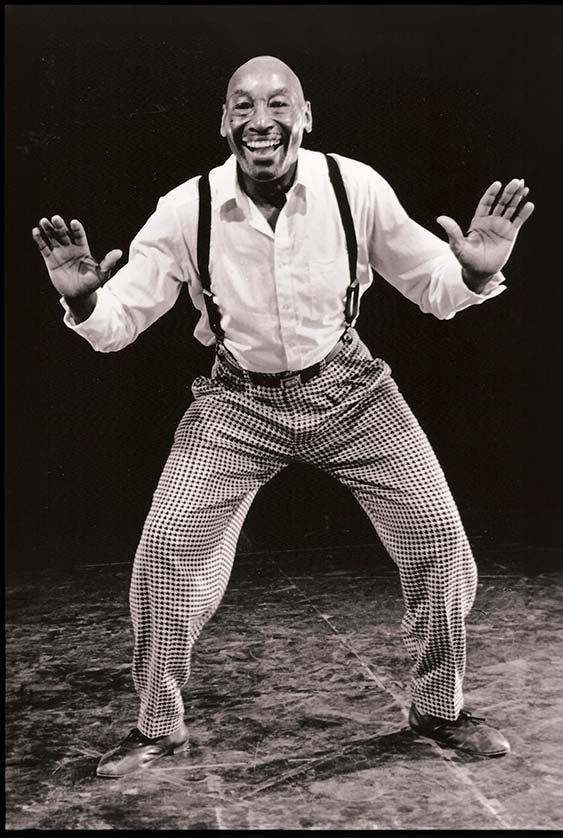
Frankie Manning, photographed by Ralph Gabriner
We’ve taken care to include an extensive array of sources, all conveniently linked at the conclusion of this article. These resources offer a wealth of information, allowing you to delve deeper into the fascinating history of Swing Dances and explore specific facets that pique your curiosity. Whether you’re interested in the origins, influential figures, or evolving styles, there’s something for everyone to discover.
If you see incorrect statements or gaps that you would like to address, please feel free to contact us!
Subscribe to our newsletter to stay up to date about the latest events, news and more.